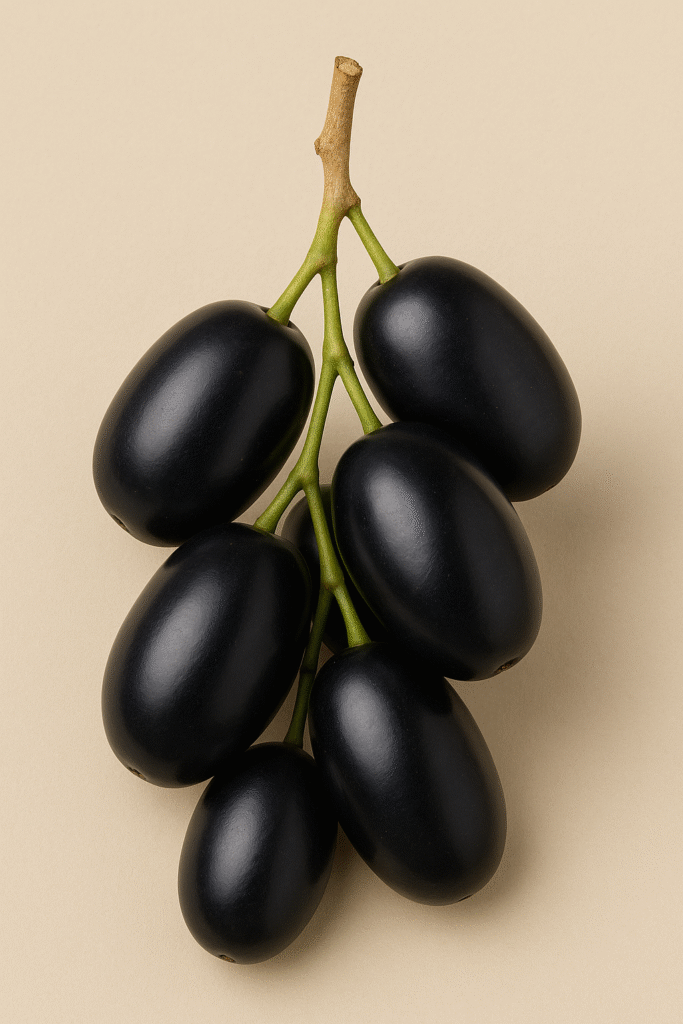The Java plum, also known in Brazil as jambolão or jamelão, is a tropical fruit tree native to South and Southeast Asia that has adapted well to Brazil’s climate. Found in various parts of the country, this plant is appreciated not only for its dark, flavorful fruit but also for its medicinal properties and ornamental value.
In this article, you’ll discover the main characteristics of the Java plum, its health benefits, common culinary uses, cultivation tips, and some fun facts about this unique tropical fruit.
Characteristics of the Java plum
The Java plum belongs to the Myrtaceae family, which includes guava and eucalyptus. It can grow up to 10 to 20 meters tall and features a dense canopy with glossy green leaves and white or pinkish flowers. The fruits are small, oval-shaped berries with a dark purple to almost black color, containing juicy pulp with an astringent, slightly sweet flavor.
Although not widely sold in mainstream supermarkets, Java plum is commonly consumed in rural areas in the form of juices, jams, wines, and syrups.
Health benefits of Java plum
Several studies highlight the nutritional and medicinal value of the Java plum. Here are some of the key benefits associated with the consumption of its fruit and other plant parts:
1. Rich in antioxidants
The dark color of the Java plum is a result of high concentrations of anthocyanins, potent antioxidants that combat free radicals in the body. These compounds help prevent premature aging and reduce the risk of chronic diseases such as cancer and cardiovascular conditions.
2. Helps control blood sugar
Java plum is popularly known as a diabetic-friendly fruit. Research shows that both the pulp and seed extract may help lower blood glucose levels. However, it should not replace conventional treatment and must be used under medical supervision.
3. Anti-inflammatory and antibacterial action
Compounds found in the Java plum have demonstrated anti-inflammatory and antimicrobial properties, helping strengthen the immune system and reducing the risk of infections.
4. Improves digestion and bowel function
The fruit is high in dietary fiber, which helps regulate intestinal transit and prevents constipation. Its astringent properties may also assist in managing mild diarrhea.
5. Good source of vitamins and minerals
Java plum contains vitamin C, which enhances immunity and iron absorption, along with minerals such as calcium, iron, phosphorus, and potassium—essential for overall health and cellular function.
How to consume Java plum
Java plum can be eaten raw, but due to its astringent taste, many people prefer it processed. Common ways to enjoy the fruit include:
- Fresh juice: Refreshing and nutritious, best served chilled.
- Jams and syrups: Cooking the fruit with sugar balances its natural tartness.
- Homemade wines and liqueurs: A traditional preparation in many Brazilian households.
- Seed powder: Often used in natural supplements or herbal remedies, especially for managing diabetes.
Both the fruit and the seed are widely used in alternative medicine, especially in Indian Ayurveda and folk Brazilian herbal practices.
Interesting facts about the Java plum
- Natural dye: Its juice stains fabrics and fingers due to its strong natural pigments, making it a potential natural food coloring agent.
- Urban landscaping: In some Brazilian cities, Java plum trees are commonly planted in public spaces. However, the fallen fruits can stain sidewalks and attract insects.
- Ayurvedic significance: In traditional Indian medicine, the fruit, leaves, bark, and seeds of Syzygium cumini are used to treat digestive issues, respiratory problems, and especially diabetes.
How to grow Java plum
Java plum trees grow well in tropical and subtropical climates. They prefer well-drained, fertile soil rich in organic matter. While relatively drought-resistant once established, the trees perform best with regular watering during dry seasons.
For home gardeners, it’s important to plant the tree in a spacious area, as it can develop a large, dense canopy. The tree is ideal for creating shade and attracting birds and pollinators.
Propagation is usually done via seeds, although grafting and air-layering are also possible for more controlled cultivation.
Final thoughts
The Java plum is a fruit with great nutritional and medicinal value, yet it remains underutilized in commercial agriculture. Its richness in antioxidants, dietary fiber, and health-promoting compounds make it a beneficial addition to the diet. With simple cultivation and high adaptability, it’s an excellent option for both rural properties and urban backyards.

Transform Your Gardening Experience!
Upgrade your garden with the Gartden Tools 10 Pcs Stainless Steel Set – designed with non-slip ergonomic handles, durable stainless steel tools, and a convenient tote bag. Perfect for women, men, and as a thoughtful gift for any gardening enthusiast!
🌱 Shop Now on AmazonDiscover the Secrets of Cumaru Wood & Tonka Beans
Explore the fascinating world of Cumaru Wood and Tonka Beans, a true natural treasure from the Amazon jungle. Learn about their history, uses, and unique aroma that has enchanted cultures for centuries.
🌿 Read More Here
